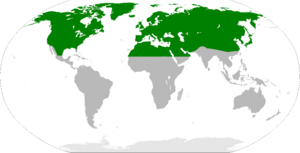Holarctic facts for kids
The Holarctic is a huge area of land that covers most of the northern parts of our planet. Think of it as a giant neighborhood for plants and animals that live in cooler climates. This area includes many different habitats, from forests to tundras.
Scientists divide the Holarctic into two main parts: the Palearctic and the Nearctic. These two parts are home to many similar kinds of plants and animals.
Contents
What is an Ecozone?
An ecozone is like a very large region of the Earth's surface. It is defined by its unique set of plants and animals. These living things have evolved together over a long time. The Holarctic is one of these major ecozones.
Two Big Parts: Palearctic and Nearctic
The Holarctic is split into two large sections. These sections are called realms.
The Palearctic Realm
The Palearctic realm is the biggest of the two. It includes all of Europe and Asia, except for the very warm parts of Southeast Asia and India. It also covers Northern Africa. This means it stretches across a huge part of the world.
The Nearctic Realm
The Nearctic realm covers most of North America. This includes Canada, the United States, and the northern parts of Mexico. It is the other half of the Holarctic ecozone.
Why are they Connected?
Even though the Palearctic and Nearctic are on different continents, they share many types of plants and animals. This is because of their shared history.
Long ago, during Ice Ages, much of the Holarctic was covered in ice. This shared past helped shape the land and its living things. Also, during these cold periods, a land bridge appeared. This bridge connected Asia and North America across the Bering Strait. Many mammals and other animals could walk across this bridge. This allowed them to move between the two continents. That is why you can find similar species in both the Palearctic and Nearctic today.
Different Ecoregions
Within the Holarctic, there are many smaller areas called ecoregions. An ecoregion is a smaller, more specific type of habitat. For example, a forest in North America might be very similar to a forest in Europe. This is because they are both part of the Holarctic. Many ecosystems, which are communities of living things and their environment, are found across these continents.
See also
 In Spanish: Holártico para niños
In Spanish: Holártico para niños


